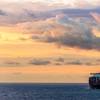Technical Committee Discusses Flexibility in Ship Design
The new "Technical Committee on Risk Management" of Germanischer Lloyd was established to respond to the growing significance of risk-based approaches for the maritime industry. The new committee's main objective is facilitation and consolidation of industry's needs related to the application of risk-based methods for future profitable maritime business.
The new "Technical Committee on Risk Management" comprises representatives from all stakeholders of the maritime industry, namely ship owners and operators, ship builder and maritime systems' suppliers, insurance and engineering service providers. Guido Schulte, Head of Concept Design and R&D Department Akeryards, was elected as chairman; further members of the Committee are Dr S. Gerhard (Allianz), Mr M. Guenther (Hamburg Süd), Mr M. Johnson (Advantica), Mr M. Müller (Hapag Lloyd), Dr S. Timmermann (MAN). Germanischer Lloyd's Senior Vice President for Strategic Research and Development, Dr Pierre C. Sames, is secretary to the committee.
The constituent meeting took place in mid-July. Germanischer Lloyd presented its risk management activities with regard to research, rule development and engineering services. The classification society is coordinator of the EU research project "SAFEDOR" on risk-based design and approval. "GL as class society traditionally focuses on risk to lives and the environment", said Dr Sames addressing GL's role.
"Rule development at GL incorporates Formal Safety Assessment," said Dr Edzard Brünner, Head of Competence Centre Rule Development. He presented the new rule development process at GL, IMO goal-based standards as future requirement for class rules, structural reliability analysis as a tool to be used to determine safety factors, the challenges involved in approving alternative design and arrangements and the requirements related to safe return to port. With "Safe Return to Port", the International Maritime Organization (IMO) has for the first time defined performance requirements for essential systems on passenger ships under predefined casualty scenarios. The coming SOLAS requirements to "Safe Return to Port" call for defined flooding as well as fire casualties the application of different and more risk based methods compared to the prescriptive requirements of today.
The committee also took a close look at the current IMO activities related to risk management. With the two concepts "goal-based standards" and "safe return to port" IMO is working on new regulations. Existing regulations and guidelines cover formal safety assessment, alternative design and arrangements for fire safety, life saving appliances and probabilistic damage stability. Dr Sames presented the results from recent high-level Formal Safety Assessment studies from the SAFEDOR project and discussed IMO risk acceptance criteria. He also outlined the discussion on environmental risk acceptance criteria.
Dr Rainer Hamann, GL Strategic Research, presented Germanischer Lloyd's current engineering projects with risk analysis as the central element. These include "safety equivalence cases": This concept allows alternative design if it is possible to demonstrate the equivalence with regard to safety to a "traditional" design. The case needs to be supported by a risk analysis. Dr Hamann also showed that GL's expertise related to risk analysis is already widely used for offshore wind parks, failure mode analyses for ship systems and for onshore installations such as locks as well as for projects of the oil and gas industry.













